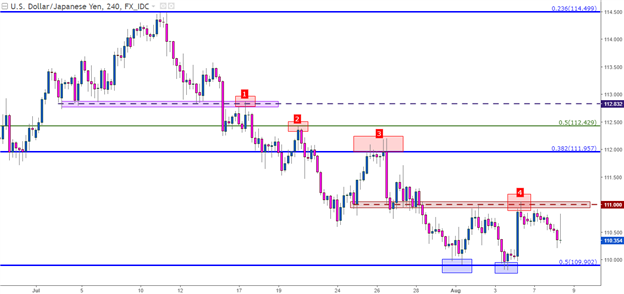Talking Points:
- In our last article, we looked at the necessity of managing risk for FX traders. In this piece, we delve into the mechanics of trading with Support and Resistance.
- Price action is the study of technical analysis without the use of indicators in the effort of removing ‘lag’ from technical analysis. Traders can utilize price action with support and resistance in the effort of taking a risk-efficient approach into markets.
- If you’re looking for trade ideas, please check out our Trading Guides. And if you’re looking for shorter-term trade ideas, please check out our IG Client Sentiment.
Price action is the permutation of technical analysis that involves stripping indicators from the charts in order to focus on the most important variable available to traders: Price itself. While battles are waged within the spread on short-term variations, longer-term charts can display potential entry and exit points that can assist traders with strategy planning. While no form of technical analysis will be perfectly predictive in nature, simply because the past doesn’t replicate in the same exact way in the future, removing technical indicators can allow traders to focus on near-term price movements without the lag often introduced with oscillators or moving averages.
In this article, we’re going to look at how traders can use price action to trade support and resistance.
Support and ResistanceGiven that markets are unpredictable, and also given that history often rhymes while it never perfectly repeats: Support and resistance are probably one of the most valuable tools available to traders, technical or otherwise. We previously looked at the necessity of risk management, and with support and resistance – traders can more adequately manage risk for their trading activities. If one wants to buy – there’s no reason to get long and just hope that it works out: Instead, wait for support to show up, so that a stop can be placed underneath that zone so that if the setup doesn’t work out, the loss can be mitigated. But if the setup does work out and if support holds, traders can sit in a winning position and scale-out as prices move-up.
The key here is finding that area of support so that the stop can be properly placed. There are a plethora of ways to find support and resistance in a market, and we previously looked at a few of the more common in our Strategy Architecture series. On the chart below, we’re adding a Fibonacci retracement over a recent ‘major move’ in USD/JPY. Drawing the retracement involves starting at the beginning of the move, and ending at the finish of the move, which would encapsulate a ‘major move’ that’s been seen on the chart. Within the move, retracement levels are applied at pre-set intervals, and those intervals are based on the golden ratio of the Fibonacci sequence of: 23.6%, 38.2%, 50% (which is the half-way point, and not a true Fibonacci number), 61.8% and 76.4%. Some traders use slightly different retracements, choosing to use 78.8% as opposed to 76.4%; but for purposes of this article, we will stay with the more popular level of 76.4%.
Recent Major Move in USD/JPY (in Red) Helping to Define Support/Resistance (in Blue)
You’ll probably notice from the above chart that support and resistance is rarely ‘perfect’. More normally, we’ll see support tested before prices may move up or we’ll see resistance breech ever so slightly before sellers can take over. The reason for this is what we mentioned earlier: Inside the spread is chaos, and if we look at the way that price action moves during news announcements, with low levels of liquidity allowing prices to swing violently, this makes sense.
The key with trading support and resistance is to be realistic in the fact that you’re probably not going to catch many exact bottoms or tops. Trying to do so is usually a quick-way into the loss column, so traders will often evaluate support or resistance inflections with current price action in the effort of trading directional momentum in a market. Let’s look at one of those prior examples in USD/JPY on a much shorter-term chart to illustrate.
From the above chart, you’ll probably notice the double-top that printed in USD/JPY around 114.30. This was the top in May and again in July; but in each case, prices were on a bee-line higher until this resistance level came into play, at which point a rather extended reversal began to play out. On the hourly chart below, we’re looking at how the first of these two resistance inflections worked-out. Notice that price first resists at this level (blue box), only for buyers to jump-back in after prices softened. Buyers re-gained control after a quick pullback (green box), but on a subsequent re-test of that resistance, buyer motivation waned and sellers began to take-over (red box).
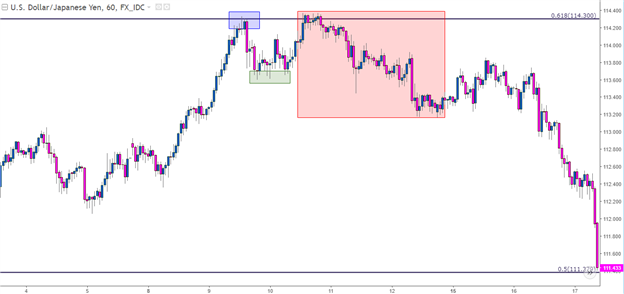
For the trader that was buying on the first break of resistance at 114.30, they probably ended up regretting it. Even buyers looking to trade the subsequent resistance break probably ended up regretting it. If we look at the same move on the four-hour chart, we’ll notice that each candle tapered up to resistance, with sellers keeping each candlestick body subdued below resistance (shown in blue). This capped gains in the pair until bears could take-over, and as we can see from the lower-low and lower-high showing after that second resistance inflection (each in red), sellers began to take over after resistance failed to yield:
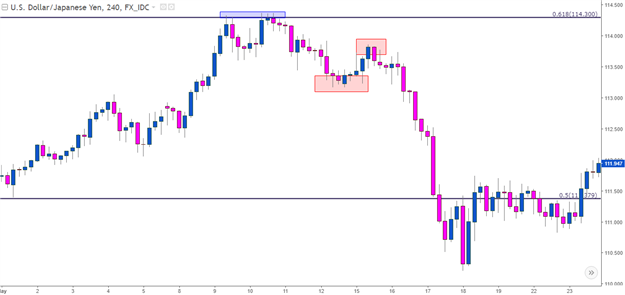 Know Your Time Frames
Know Your Time FramesThe key variable in the above relationship was one of patience: To the trader quickly acting on the first test of resistance, they likely ended up in a losing trade. This is not to say that breakouts cannot happen and that every support and resistance level will hold; but for the trader taking a patient approach, they could’ve waited for the four-hour candle close to highlight those wicks above resistance as evidence that sellers were responding to this zone; opening the door to potential short-side reversal scenarios.
As those four-hour candles closed with wicks around resistance, this opened the door for a short-side reversal setup so that the trader can look to place stops on the other side of resistance. This would allow for a relatively small risk outlay so that if resistance did end up breaking – the damage could be mitigated. But if that resistance did hold and if sellers were able to take control, the potential upside could be rather large compared to that initial risk outlay.
We discussed the various time frame relationships in the article, The Time Frames of Trading. In that piece, we discuss multiple time frame analysis as a way to more-fully grasp what’s going on with price action at the time. This can allow traders to utilize longer time frames to read trends and grade market conditions, while using shorter-term time frames to look for entries in the direction of that ‘bigger picture’ market environment. On the table below, we look at popular time frames for various approaches or, by ‘desired holding period’.
 Look for Wicks on Closed Candles to Highlight Support/Resistance Reactions
Look for Wicks on Closed Candles to Highlight Support/Resistance ReactionsAfter traders have identified potential support and resistance levels and after the actionable time frames have been decided upon, traders can then look to confirm support and resistance by looking for reactions around these levels. Candlestick wicks can be used to help highlight reactions. If prices temporarily dip below a support level, only for bidders to bring price back-above, then a wick will show through that price, and this is highlighting a potential reaction that can be used to trade that level. Let’s look at a recent move in EUR/USD to help illustrate:
Coming into Non-Farm Payrolls last Friday, EUR/USD had been on a rather brisk top-side run. Over the previous seven months, the pair had climbed by more than 1,400 pips, with 700+ of those arriving since mid-June. If we draw a Fibonacci retracement around the major-move that started in latter-July, the 38.2% retracement from that level comes-in at 1.1743.
After Dollar-strength took over on the back of a rather solid NFP report, EUR/USD began to drive-lower in a counter-trend move. Prices moved all the way down to the 38.2% retracement, at which point buyers responded, as you can see from the under-side wick highlighted in red on the below chart.
EUR/USD Hourly: Three Consecutive Wicks at Fib Support Highlight Buyer reaction
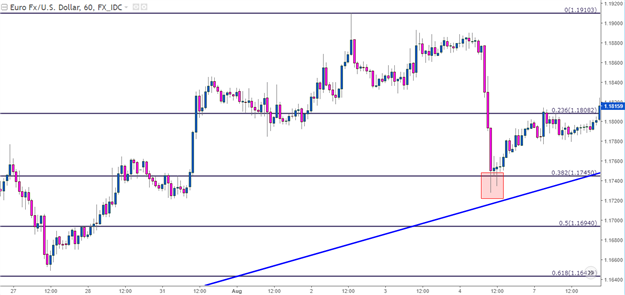
The benefit here isn’t that the above wicks show that the down-side move is over; it’s in the fact that this highlights an area where traders can look at a risk-efficient way of trading the continued up-trend in the pair. The fact that buyers had responded in this region merely highlights the potential for support, with the possibility of a tight stop for continuation approaches. Let’s look at another example to help illustrate, but this time we’re going to look at the Japanese Yen. We’re going to look at a longer-term move here, as well, as we’ve drawn a Fibonacci retracement around the ‘post-Election’ move in the pair, taking the election night-low up to the high set on January 3rd, shown below.
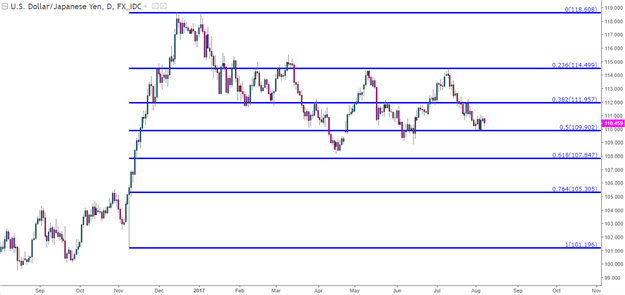
Over the past two months, we’ve seen a rather range-bound move in USD/JPY, as the pair has oscillated between 109.00 and 114.50. But despite this lack of discernable direction on longer-term charts, the Fibonacci retracement produced from the above major move has helped to set support and resistance on the four-hour chart numerous times. On the below chart, we’re illustrating resistance inflections in red and support in blue; and notice how that while not every inflection ‘holds’, the ones that do lead-in to rather extended runs.
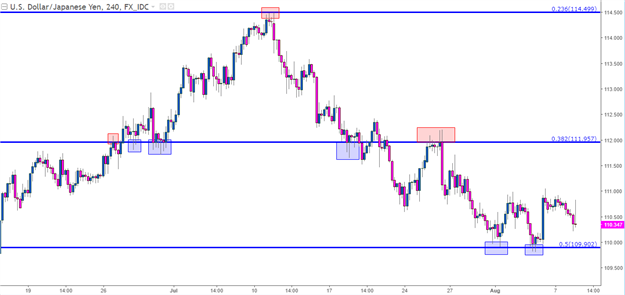
Notice how the apex of the reversal in the above chart shows right at the 23.6% retracement at 114.50, while near-term support followed by resistance showed at the 38.2% while, at least so far the lows have been cauterized at the 50% retracement. Each of these reactions can be actionable, in one way or another.
Applying Trend-Side BiasesTraders looking to trade a directional move can benefit greatly from support and resistance analysis, as it can allow the trader to buy uptrends at support or sell down-trends at resistance in a relatively risk-efficient manner. For up-trends, potential resistance can be used as profit targets, while support can be utilized for re-entry or stop placement. For down-trends, potential support levels become targets while resistance can be used to add to the position or to set stops.
We can even add support and resistance from other avenues, such as psychological levels or pivot points or even other Fibonacci retracements. This can add significant texture to the chart to allow the trader to more efficiently manage their risk. On the chart below, we’ve focused-in on this recent move lower in USD/JPY to illustrate how this can be done. In purple, we’ve outlined a prior support swing that eventually showed-up as resistance. We’ve also added a second Fibonacci retracement, taking the June 2015 high down to the June 2016 low, shown in Green.
After prices break below the purple zone, we have lower-lows and lower-highs. Traders, at that point, would likely want to move forward with a bearish side-bias in the effort of trading in the direction of the trend. And given that traders would likely want to be selling resistance to jump-in the down-trending direction, we’ve outlined four various areas where this took take place at. 1) Prior price action support around 112.83 becomes fresh resistance as prices break-lower. 2) Resistance shows at the 50% retracement of the longer-term Fibonacci retracement. 3) Resistance shows at prior support at the 38.2% retracement of the shorter-term move and finally 4) psychological support at 111.00 becomes new resistance.
For each of these reactions, the candlestick wick showing sellers responding to resistance open the door for entries in the direction of the trend.
Combining Methodologies: Sell Resistance on the Way Down, Buy Support on the Way Up
